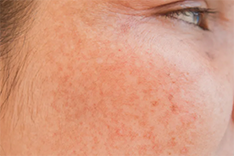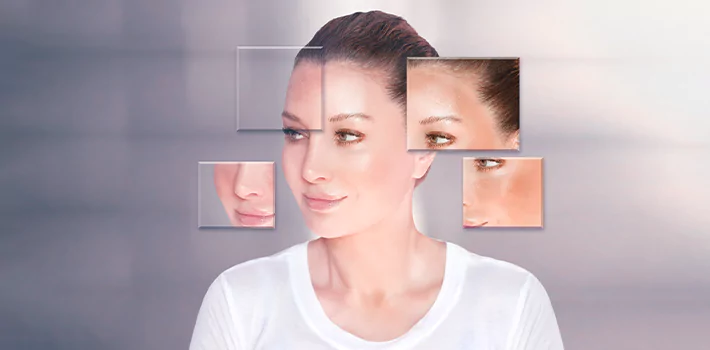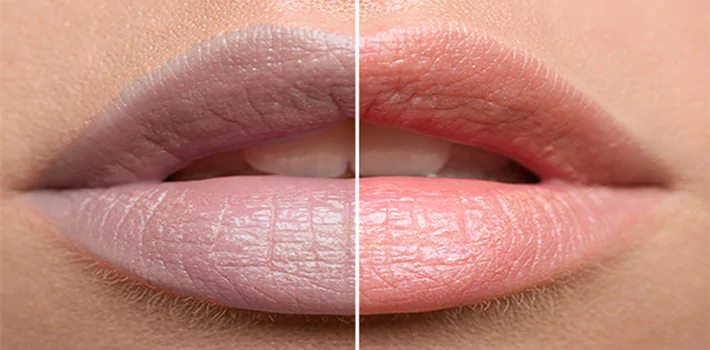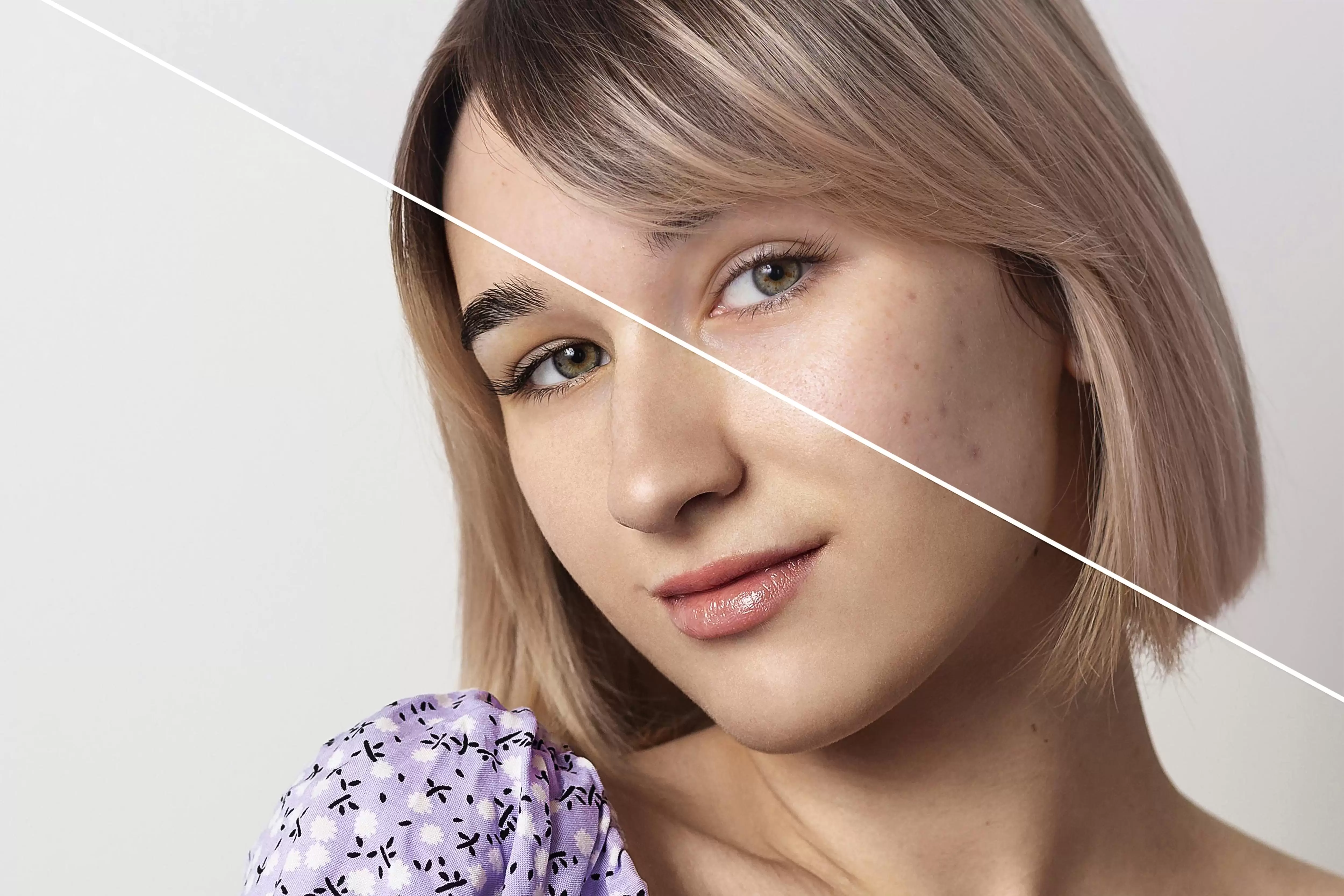Hyperpigmentation is a broad term that refers to one of the most widespread skin issues: "Discoloration"
It refers to patches of skin that become darker than the surrounding areas of skin. It occurs when the skin produces excess melanin that is responsible for giving the skin its color.
People with darker skin tones are more prone to hyperpigmentation, especially with excess sun exposure, as darker skin tones already have a higher melanin content. It can appear as brown, black, gray, red or pink spots or patches.
There are several types of hyperpigmentation, each of it has its own identifying features and treatment options. In this article, find out about the five most common types of pigmentation and its different causes and treatments.
Types of hyperpigmentation:
There are several types of hyperpigmentation, the common ones being melasma, freckles, post-inflammatory hyperpigmentation, Hormonal Pigmentation and sun spots.
|
1- Melasma Melasma is believed to be caused by hormonal changes and may develop during pregnancy. Areas of hyperpigmentation can appear on any area of the body, but they appear most commonly on the stomach and face. |
 |
Fast facts about melasma:
Cause: ultraviolet infrared and hormones
Color: brown or blue-gray
Appearance: flat, dark patches, may be symmetrical
on each side of the face.
Where It Occurs: cheeks, nose, chin, above the upper lip and the forehead.
In fact, melasma can affect any part of your skin that is exposed to sunlight.
|
2- Freckles Freckles are small brown spots typically found in fair-skinned people, especially in children with red hair. They are more prominent in summer and fade significantly or disappear in winter. People with freckles in childhood may find that themarks become less obvious in adulthood. |
 |
Fast facts about freckles:
Cause: hereditary
Color: light to dark brown, tan
Appearance: flat, any shape (often round), usually appear in concentrated clusters
Where It Occurs: face, chest, arms, legs
|
3- Post-inflammatory hyperpigmentation This type of pigmentation happens when the skin makes extra melanin following an injury (e.g. a burn) or an inflammatory skin condition (e.g. acne). People with darker skin tones are more susceptible. Although the marks may fade on their own, they can last for months or even years. |
 |
Fast facts about post-inflammatory hyperpigmentation:
Cause: damage or irritation to the skin
Color: pink, red, purple, brown, tan, grey
Appearance: flat, darkened patches that resemble a stain in the skin
Where It Occurs: previous sites of injury or inflammation
|
4- Hormonal Pigmentation This type of pigmentation develops due to fluctuations in hormones. It may be natural or a side effect of medication or medical treatment. Hormonal pigmentation disproportionately affects women and Fitzpatrick skin types IV-VI, and usually appears on sun-exposed areas of the skin. |
 |
Fast facts about hormonal pigmentation
Cause: hormonal imbalances
Color: light to medium brown, grey-brown
Appearance: large and blotchy dark patches, may be symmetrical on each side of the face
Where It Occurs: forehead, cheeks, jaw, temples, upper lip
|
5- Sun Spots Hyperpigmentation due to photoaging (sun damage) goes by many names, including sun spots, age spots, liver spots and solar lentigines. These dark spots are a common part of skin aging and often appear after age 40. They are more prevalent in people with fair skin. |
 |
Fast facts about sun spots:
Cause: UV exposure
Color: light brown to black
Appearance: flat, clearly defined edges, larger than freckles
Where It Occurs: face, backs of hands, shoulders, forearms, chest
Types of treating hyperpigmentation:
There are a wide range of depigmenting treatments used for hyperpigmentation conditions, and responses to most are variable. Most often treatment of hyperpigmentation caused by melanin overproduction (such as melasma, sun spots, freckles) includes the use of topical depigmenting agents, which vary in their efficacy and safety, as well as in prescription rules.
1- Topical treatments:
Many people use topical treatments to treat hyperpigmentation. Topical treatments will include ingredients that can lighten your skin up, such as: cysteamine, arbutin, niacinamide, vitamin C, glycolic acid peels, N-acetyl glucosamine, mequinol and soy.
Here you are the most recommended products by dermatologist that can help you treating hyperpigmentation and dark spots:
https://www.se7rek.com/ar/product/cyspera-intensive-pigment-corrector-50gm-7454-1192
https://www.se7rek.com/ar/product/obagi-nu-derm-blender-5-lightening-cream-57gm-9302-3197
https://www.se7rek.com/ar/product/royce-whitening-serum-30ml-8297-6640
https://www.se7rek.com/ar/product/retinol-skin-brightener-30ml-6789-9825
People should speak with a doctor before using skin-lightening products, as they may cause adverse effects. Always purchase products from a reputable source and follow the instructions on the pack.
2- Cosmetic procedures:
Some cosmetic procedures can also lighten areas of skin to reduce the appearance of hyperpigmentation, which includes:
- laser therapy.
- intense pulsed light.
- chemical peels.
People considering whether to undergo one of these procedures should discuss the process and possible side effects with a skin care specialist or dermatologist. As they can possibly worsen hyperpigmentation by injuring the outer layer of the skin.
Hyperpigmentation is a broad term that refers to one of the most widespread skin issues: "Discoloration"
It refers to patches of skin that become darker than the surrounding areas of skin. It occurs when the skin produces excess melanin that is responsible for giving the skin its color.
People with darker skin tones are more prone to hyperpigmentation, especially with excess sun exposure, as darker skin tones already have a higher melanin content. It can appear as brown, black, gray, red or pink spots or patches.
There are several types of hyperpigmentation, each of it has its own identifying features and treatment options. In this article, find out about the five most common types of pigmentation and its different causes and treatments.
Types of hyperpigmentation:
There are several types of hyperpigmentation, the common ones being melasma, freckles, post-inflammatory hyperpigmentation, Hormonal Pigmentation and sun spots.
1- Melasma
Melasma is believed to be caused by hormonal changes and may develop during pregnancy. Areas of hyperpigmentation can appear on any area of the body, but they appear most commonly on the stomach and face.
Fast facts about melasma:
Cause: ultraviolet infrared and hormones
Color: brown or blue-gray
Appearance: flat, dark patches, may be symmetrical
on each side of the face.
Where It Occurs: cheeks, nose, chin, above the upper lip and the forehead.
In fact, melasma can affect any part of your skin that is exposed to sunlight.
2- Freckles
Freckles are small brown spots typically found in fair-skinned people, especially in children with red hair. They are more prominent in summer and fade significantly or disappear in winter. People with freckles in childhood may find that themarks become less obvious in adulthood.
Fast facts about freckles:
Cause: hereditary
Color: light to dark brown, tan
Appearance: flat, any shape (often round), usually appear in concentrated clusters
Where It Occurs: face, chest, arms, legs
3- Post-inflammatory hyperpigmentation
This type of pigmentation happens when the skin makes extra melanin following an injury (e.g. a burn) or an inflammatory skin condition (e.g. acne). People with darker skin tones are more susceptible. Although the marks may fade on their own, they can last for months or even years.
Fast facts about post-inflammatory hyperpigmentation:
Cause: damage or irritation to the skin
Color: pink, red, purple, brown, tan, grey
Appearance: flat, darkened patches that resemble a stain in the skin
Where It Occurs: previous sites of injury or inflammation
4- Hormonal Pigmentation
This type of pigmentation develops due to fluctuations in hormones. It may be natural or a side effect of medication or medical treatment. Hormonal pigmentation disproportionately affects women and Fitzpatrick skin types IV-VI, and usually appears on sun-exposed areas of the skin.
Fast facts about hormonal pigmentation
Cause: hormonal imbalances
Color: light to medium brown, grey-brown
Appearance: large and blotchy dark patches, may be symmetrical on each side of the face
Where It Occurs: forehead, cheeks, jaw, temples, upper lip
5- Sun Spots
Hyperpigmentation due to photoaging (sun damage) goes by many names, including sun spots, age spots, liver spots and solar lentigines. These dark spots are a common part of skin aging and often appear after age 40. They are more prevalent in people with fair skin.
Fast facts about sun spots:
Cause: UV exposure
Color: light brown to black
Appearance: flat, clearly defined edges, larger than freckles
Where It Occurs: face, backs of hands, shoulders, forearms, chest
Types of treating hyperpigmentation:
There are a wide range of depigmenting treatments used for hyperpigmentation conditions, and responses to most are variable. Most often treatment of hyperpigmentation caused by melanin overproduction (such as melasma, sun spots, freckles) includes the use of topical depigmenting agents, which vary in their efficacy and safety, as well as in prescription rules.
1- Topical treatments:
Many people use topical treatments to treat hyperpigmentation. Topical treatments will include ingredients that can lighten your skin up, such as: cysteamine, arbutin, niacinamide, vitamin C, glycolic acid peels, N-acetyl glucosamine, mequinol and soy.
Here you are the most recommended products by dermatologist that can help you treating hyperpigmentation and dark spots:
https://www.se7rek.com/ar/product/cyspera-intensive-pigment-corrector-50gm-7454-1192
https://www.se7rek.com/ar/product/obagi-nu-derm-blender-5-lightening-cream-57gm-9302-3197
https://www.se7rek.com/ar/product/royce-whitening-serum-30ml-8297-6640
https://www.se7rek.com/ar/product/retinol-skin-brightener-30ml-6789-9825
People should speak with a doctor before using skin-lightening products, as they may cause adverse effects. Always purchase products from a reputable source and follow the instructions on the pack.
2- Cosmetic procedures:
Some cosmetic procedures can also lighten areas of skin to reduce the appearance of hyperpigmentation, which includes:
- laser therapy.
- intense pulsed light.
- chemical peels.
People considering whether to undergo one of these procedures should discuss the process and possible side effects with a skin care specialist or dermatologist. As they can possibly worsen hyperpigmentation by injuring the outer layer of the skin.














